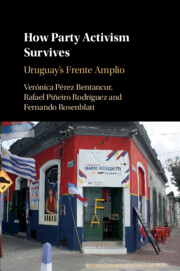Book contents
- How Party Activism Survives
- How Party Activism Survives
- Copyright page
- Dedication
- Contents
- Figures
- Tables
- Boxes
- Acknowledgments
- Abbreviations
- 1 Introduction
- 2 Context Matters
- 3 Voluntary Activism in the FA
- 4 Origins and Reproduction of the Mass-Organic Structure
- 5 Party Structure, Efficacy, and Activism
- 6 The Limits to Strategic Adaptation
- 7 The FA in Comparative Perspective
- 8 Theoretical Conclusions and Political Implications
- Appendix – Interviewees
- References
- Index
7 - The FA in Comparative Perspective
Published online by Cambridge University Press: 28 October 2019
- How Party Activism Survives
- How Party Activism Survives
- Copyright page
- Dedication
- Contents
- Figures
- Tables
- Boxes
- Acknowledgments
- Abbreviations
- 1 Introduction
- 2 Context Matters
- 3 Voluntary Activism in the FA
- 4 Origins and Reproduction of the Mass-Organic Structure
- 5 Party Structure, Efficacy, and Activism
- 6 The Limits to Strategic Adaptation
- 7 The FA in Comparative Perspective
- 8 Theoretical Conclusions and Political Implications
- Appendix – Interviewees
- References
- Index
Summary
There have been other mass-organic parties in Latin America. This chapter discusses the FA case in comparative perspective. The literature has emphasized the role of exogenous factors or the ability of party leaders to strategically “adapt” to explain the transformation of formerly mass-organic parties. The case of the FA, which confronted similar exogenous challenges, calls attention to the relevance of organizational structure in determining party activists’ level of engagement. Organizational design is crucial for fostering and reproducing activism. The chapter reviews the case of the Partido dos Trabalhadores (PT) in Brazil, a former mass-organic leftist party that turned into a professional–electoral party. The PT is the case that most closely resembles the FA in its emphasis on grassroots activism. The comparison with the PT, as a negative case, increases the theory’s analytical leverage. Second, the chapter discusses the case of the FA as a strange electoral alliance or coalition. It compares the case of the FA with other leftist coalitions in Latin America, with a special focus on the experiences of leftist coalitions in Chile, showing that the FA developed a distinctive, shared organizational structure that is not observable in other, similar electoral alliances.
Keywords
- Type
- Chapter
- Information
- How Party Activism SurvivesUruguay's Frente Amplio, pp. 145 - 159Publisher: Cambridge University PressPrint publication year: 2019

